I’ve done a fair amount of backpacking, but I had some trouble deciding what to pack for my trip on the Berg Lake Trail in early September. The trail is at a high elevation in the Canadian Rockies, so I knew the weather would potentially be colder and wilder than I am used to. As well, we planned to spend 5 days on the trail so I wanted to make sure I packed light to make up for all the food I’d have to haul. It actually snowed heavily on our last day on the trail and we met quite a few inexperienced hiker who had to turn around since they weren’t prepared for the conditions. Now that I’m back, I know exactly what I’d pack next time (and what I wish I brought on my first trip!). So here it is: a super extensive list of what to pack for the Berg Lake Trail in Mount Robson Provincial Park, British Columbia.
Hey there: Some of the links in this post are affiliate links, which means I earn a small commission at no extra cost to you if you make a purchase. Thanks for supporting my website! -Taryn
Essentials
Trail Permits and Campsite Reservations
You need a trail permit and campsite reservations to hike the Berg Lake Trail. You can reserve campsites online in advance of your trip (check out my Berg Lake Trail hiking guide for more info on making reservations). The day you start the trail you need to check in at the Mount Robson Provincial Park visitor centre to pick up your permits. The park ranger will give you a laminated permit that you need to hang on the outside of your backpack and attach to your tent. You need to show your permit to the rangers if they ask.
READ NEXT: BC Backpacking Reservation Dates You Need to Know
Guidebook and Map (optional)
The Berg Lake Trail has excellent signage so you don’t really need to bring a topographic map or guidebook with you. However, I brought photocopies of our guidebook with us and they were really helpful since they told us what to expect on the trail in each section. (The signs only told us how far away something was.)
I recommend: I like Don’t Waste Your Time in the Canadian Rockies by Craig and Kathy Copeland. They have a no BS attitude that’s refreshing. Check prices: Amazon | MEC.
Compass and/or GPS (optional)
We carry a GPS on all our hikes since we like to be able to tell how far we have walked (and therefore how much further we have to go). We didn’t need the GPS for navigation at all on the Berg Lake Trail since it was so well marked.
I recommend: We use a basic Garmin eTrex 30x GPS. It has an easy to use interface and isn’t too expensive. Check prices: MEC | REI | Amazon.
Backpacks and Bags
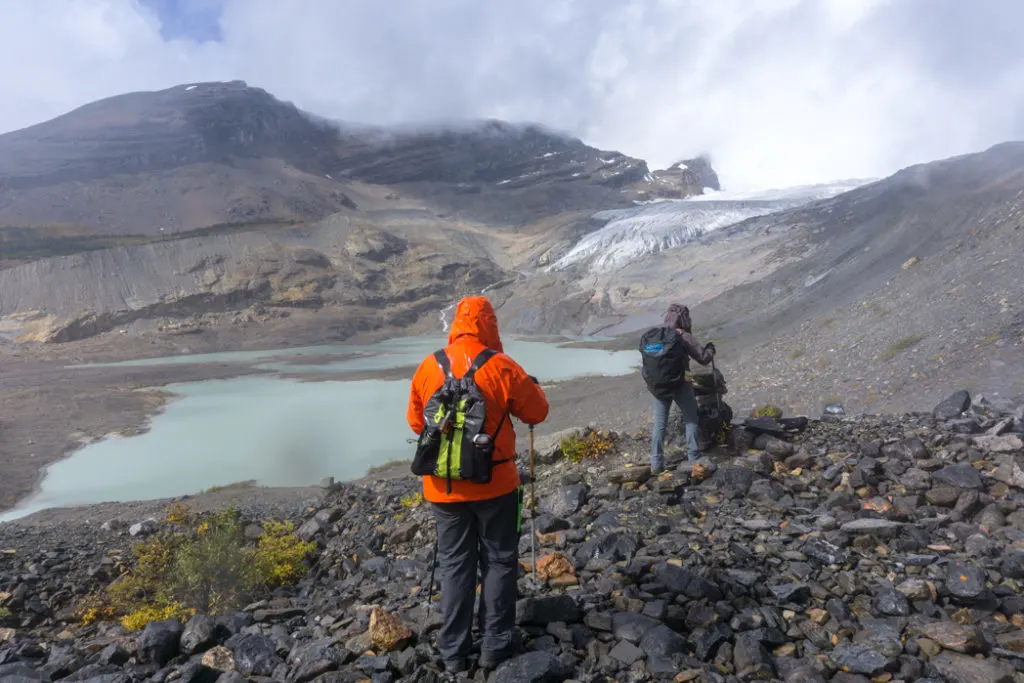
Backpack
You’ll want to pack all your gear for the Berg Lake Trail inside a backpack. Something between 50 and 75L is probably a good size. Be sure to do a test pack at home to make sure all your gear fits. Make sure you choose a backpack that fits you well and is comfortable to carry.
I recommend: I have a Gregory Amber 65. Check prices: MEC | REI | Amazon. My husband really likes his Gregory Stout 70. Check prices: MEC | REI | Amazon.
Day Pack (Optional for Day Hikes)
If you’re staying a few nights at Berg Lake and day hiking in the area, you might want to bring a small packable day pack. (Or you can just use your main backpack). If you do bring a day pack, choose one that’s about 20L in size: big enough to carry water, a first aid kit, snacks and extra clothes in case it warms up or cools down.
I recommend: I have the MEC Travel Light Top Load Pack. My husband likes the Outdoor Research Dry Summit Pack since it doubles as a dry bag for his clothes inside his main backpack on the hike in. Check prices: Amazon | Outdoor Research.
Stuff Sacks and Organizers
To stay organized I like to pack my gear in a combination of different sized stuff sacks. I also bring lots of Ziploc freezer bags to keep wet gear separated and keep electronics dry and protected.
I recommend: I like the Sea to Summit Ultra-Sil dry bags. They’re waterproof but still incredibly lightweight. Check prices: REI | Amazon.
Rain Protection
If your gear gets wet, it can really ruin your trip. We did the Berg Lake trail at the beginning of September and unfortunately it rained a bit most days and even snowed on our last day. I brought a rain cover for my backpack and also brought a couple big black garbage bags to wrap up gear inside my pack.
I recommend: Some packs come with a custom sized rain cover. If yours didn’t, buy a lightweight silnylon one that fits your pack well. Pro tip: If you tend to overstuff your pack or attach things to the outside, buy a slightly larger sized rain cover. Check prices: MEC | REI | Amazon.
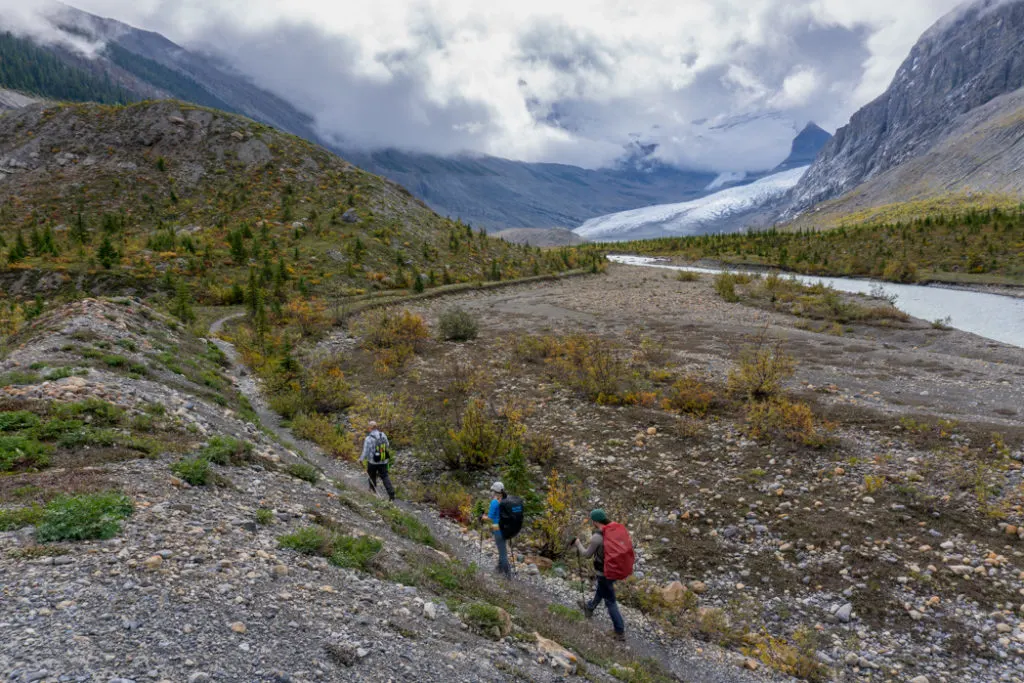
Tent and Sleeping Gear
Tent
The Berg Lake trail is a serious mountain trek so you need a proper backpacking tent. Get one that is lightweight, compact and has a full length waterproof rain fly. You can get bad weather at any time up there, so this isn’t the place for a cheap big box store tent that will leak.
You will also want to pack a free standing tent. (By which I mean one that doesn’t rely entirely on pegs and ropes to keep it upright.) Some of the campsites on the Berg Lake Trail use wooden tent platforms and it’s close to impossible to set up a non-freestanding tent on one of those. As well, the campsites aren’t large so huge tents don’t fit. Split your group up into several 2 or 3 person tents. And sadly, if you are a hammock camper, they aren’t allowed on this trail so you’ll have to go back to being a ground-dweller.
I recommend: I’ve been using MSR Hubba Hubba tents for over a decade and I can’t say enough good things about them. (Well except that they aren’t cheap!) Check prices: MEC | REI | Amazon. If the Hubba Hubba isn’t in your budget, check out the MSR Elixir. Check prices: MEC | REI | Amazon.
Sleeping Bag and Compression Sack
The campsites at Berg Lake are at an elevation of 1650m (5400ft) and it can be cold up there any time of year. Pack a lightweight and compressible sleeping bag rated at least 5C/41F but preferably more like -10C/23F. Choose one with a hood for extra warmth. Make sure you pack your sleeping bag inside a compression sack so it takes up less space in your pack.
I recommend: I sleep cold so on the Berg Lake Trail I chose to bring my winter sleeping bag, the Therm-a-Rest Oberon. Check prices: MEC | Amazon | Backcountry. It was overkill, but I was definitely warm! I like the Outdoor Research Ultralight Compression sacks and they come in lots of sizes. Buy: MEC | Outdoor Research | Amazon.
Sleeping Pad
Even the warmest sleeping bag can’t protect you from the cold, hard ground. You’ll need a sleeping pad for that. Choose one that is compact, lightweight and has an R value of at least 2.5. (R value measures insulation and warmth). If you expect cold weather or know you feel the cold at night, pick a pad with an even higher R value.
I recommend: I use a Therm-a-rest NeoAir Xtherm since I sleep really cold. Check prices: REI | Amazon. My husband likes his NeoAir XLite which weighs less but isn’t quite as warm. Check prices: MEC | REI | Amazon.
Pillow (Optional)
You can use a bunched up jacket as a pillow, but bring a compact camping pillow to save your neck.
I recommend: I use a simple MEC inflatable pillow. For a slightly more deluxe experience check out the Sea to Summit Aeros Pillow Premium. Check prices: MEC | REI | Amazon.
Ear Plugs (Optional)
Some of the tent pads are very close to each other or to the trail. If you’re a light sleeper, ear plugs are a must.
I recommend: Bring a few pairs of cheap foam earplugs. You’re bound to lose some so it’s good to have extras. I like the contoured ones since I find they fit in my ears better.
READ NEXT: How to Stay Warm in a Tent: Over 40 Tips
Clothing
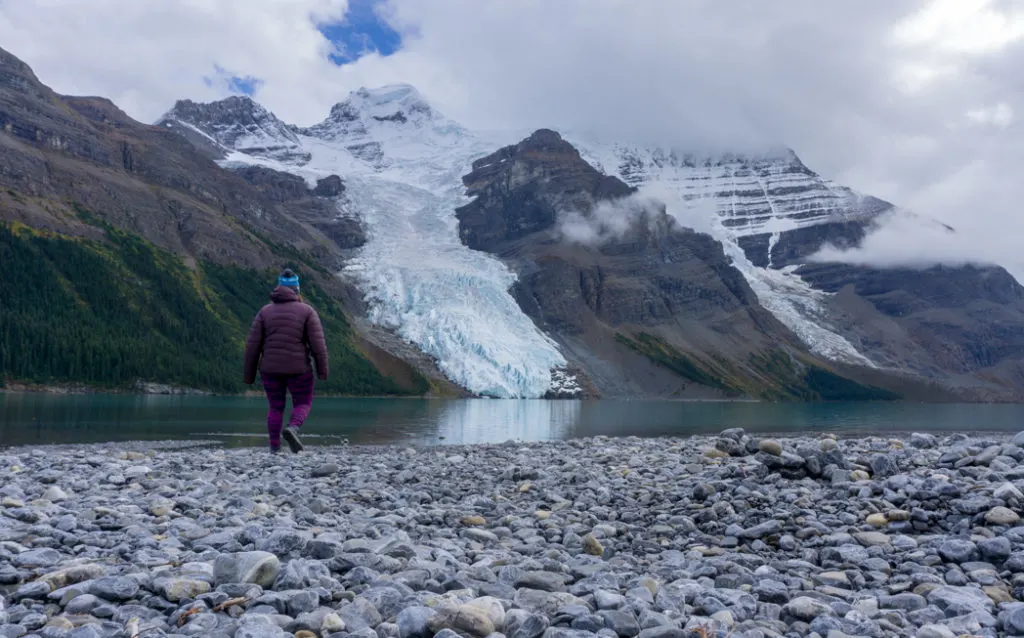
Hiking pants or tights (1 pair)
Choose quick-drying hiking pants made of nylon or polyester (and maybe with a bit of spandex for stretch). My husband likes convertible pants that zip off into shorts, but I don’t find them that comfortable. Like a lot of women, I sometimes hike in running tights.
I recommend: I love my MEC Terrena Stretch pants. I also like the Prana Halle Pants. Check prices: MEC | REI | Amazon. For guys, my husband recommends the MEC Mica Pants. If you like convertible pants, the Prana Stretch Zions are a great option. Check prices REI | Amazon.
READ NEXT: 12 Best Women’s Hiking Pants (Picks for Every Body Type)
Shorts (1 pair)
The Berg Lake trail starts at a lower elevation so the first part of the trail can be much warmer. And unless you hike very early or late in the season, it will likely be warm enough for shorts at the lake on sunny days. You may want a pair of quick drying hiking shorts for this type of weather.
I recommend: The Black Diamond Valley Shorts are my favourite hiking shorts. Check prices: Black Diamond | Amazon. They’re really lightweight, dry quickly and aren’t too short. They also come in a men’s version. Check prices: Black Diamond | Amazon.
Tank tops or t-shirts (1 or 2)
I usually hike in quick-drying workout t-shirts or tanks and I brought 2 to Berg Lake. You could also bring a couple button up trekking shirts. If your trip is shorter you can just bring one shirt, but for trips over 3 days I like to bring two shirts and alternate between them so they can air out.
I recommend: I love the Patagaonia Nine Trails shirt since it looks like a regular t-shirt but wicks sweat and resists odours. Check prices: REI | Patagonia. But any old quick dry workout t-shirt will do. You can pick them up for cheap at big box stores or mall stores.
Long sleeved shirt (1)
A long sleeved shirt is a good layer for sun protection or for a bit more warmth on cold mornings. I prefer to wear a long sleeved shirt with buttons or a zip neck so that I have venting options.
I recommend: Look for a long sleeved zip-neck or button up with UPF sun protection. In warmer weather I like a button up trekking shirt and in colder weather I wear a zip neck base layer like the Patagonia Capilene Midweight. Check prices: MEC | Patagonia | REI.
Fleece Jacket or Light Weight Puffy Jacket
At high elevations or on cold mornings you will need a warm layer to hike in. Pack a fleece jacket or a lightweight puffy jacket that you can layer on over a t-shirt and under your rain jacket. If you hike to Berg Lake in June or September, opt for a warmer puffy.
I recommend: I have a MEC Rockwall Midlayer fleece that absolutely love. It’s so soft on the inside. I often pair it with my MEC Boundary Light Down Vest for extra warmth It packs down really small. My husband loves his Patagonia Nano Puff Jacket. For a synthetic puffy it’s really light and warm. It comes in a women’s version too. Check prices: MEC | REI | Patagonia | Amazon.
Rain jacket
You definitely should pack a rain jacket for the Berg Lake trail since it can rain or snow at any time. Mount Robson makes its own weather! And even if it doesn’t rain, a jacket is great for blocking the wind. Bring a waterproof breathable rain jacket designed for hiking – preferably one with pit zips for venting.
I recommend: My husband and I both really love our 3 layer Gore Tex MEC Synergy Jackets. If you want something lighter and more compact, the Outdoor Research Helium II is a great option. Check prices: Outdoor Research | REI | Amazon. I also have a MEC Flash Cloud Jacket that I bring on summer trips. It’s really tiny but still Gore Tex!
Rain Pants
Pack a pair of waterproof breathable rain pants that you can easily layer over top of your hiking pants. I like ones with side zippers for venting that are easy to put on and take off without removing your shoes.
I recommend: I have the MEC Hydrofoil Stretch Rain Pants. They have side zips, which are great for venting. The Outdoor Research Helium Pants are much lighter because they don’t have zips. Check prices: Outdoor Research | REI | Amazon.
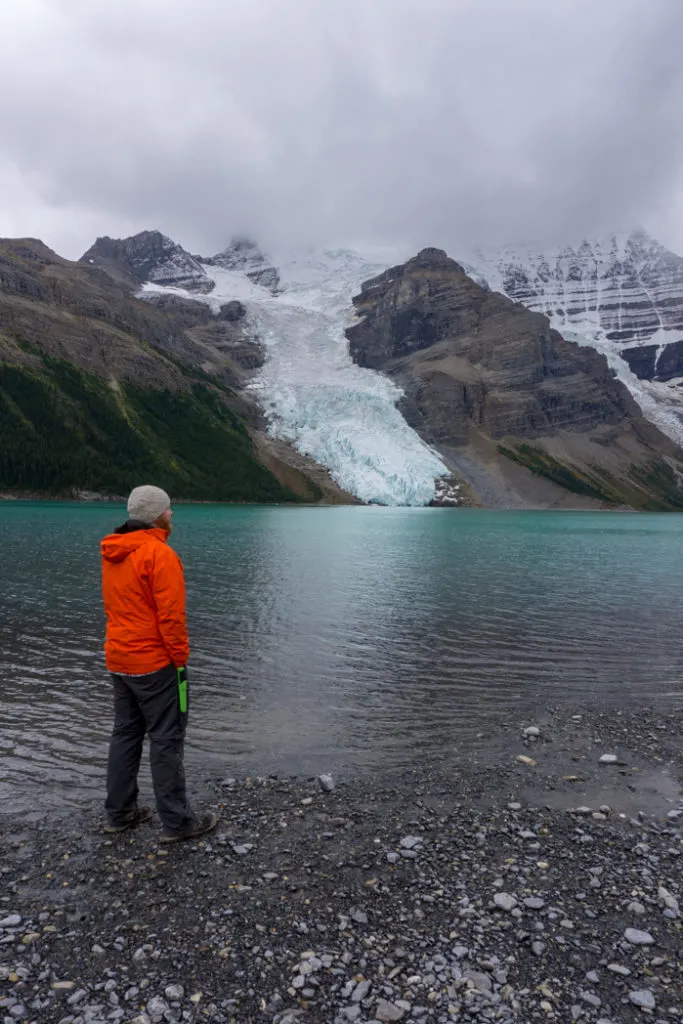
Long Underwear
It gets cold up high in the mountains, especially at night so make sure you pack some warm long underwear, also known as a base layer. Choose mid-weight long underwear made of polyester or merino wool and be sure to pack both long underwear bottoms and a long sleeved top.
I recommend: I sleep cold so I wear a MEC T3 base layer top with a hood and matching bottoms. My husband likes Patagonia’s Capilene Midweight long underwear. Check prices: REI | Patagonia.
Sports bra
You don’t need a ton of support for trekking, so try to choose a bra without a lot of fabric layers that will take a long time to dry.
I recommend: I really like the Knixwear bras for trekking since they are super lightweight, don’t absorb too much moisture and are seamless so they don’t chafe. They offer enough support for my larger chest when I adjust the straps to cross back.
If you are smaller chested, check out the Patagonia Barely Bra. Check prices: MEC | Patagonia | REI.
Underwear (2 or 3 pairs)
I like to bring two kinds of underwear on long trips: two or three pairs of quick drying synthetic underwear for trekking and one pair of comfortable cotton underwear for wearing at night. Seamless underwear will be way more comfortable for hiking in, since they prevent chafing. Many of the guys I hike with swear by boxer briefs with a built in pouch to prevent their package from rubbing the inner thighs.
I recommend: I wear Patagonia’s Active underwear because they’re seamless and don’t chafe when I’m sweaty. Check prices: REI | Patagonia. The guys I hike with can’t stop talking about how much they love Saxx boxer briefs. Check prices: MEC | REI.
Read my guide to hiking underwear for more quick-dry underwear picks as well as advice on how to choose the best hiking underwear.
Warm Hat
Americans call it a beanie. Canadians call it a toque. No matter what you call it, don’t forget to pack a warm hat on your hike to Berg Lake. Bring a fleece or wool one that covers your ears
Sun Hat and Sunglasses
The sun can be harsh at high elevations, especially above the tree line so you may want to bring a wide brimmed hat or baseball cap and a pair of sunglasses to give you a bit of protection.
I recommend: My go to hiking hat is the Sunday Afternoons NorthWest Trucker. Check prices: Amazon | Backcountry. I like to wear polarized sunglasses as they cut let you see colours that are truer to reality than what you get with regular sunglasses. I like Sunskis since they have fun frame options and they aren’t too expensive for polarized glasses. Check prices: REI | Amazon.
Gloves
Simple fleece or wool gloves will be enough to keep your hands warm at high elevations or on cold mornings. But if you are trekking in the winter or feel the cold easily, insulated ski gloves are a better bet.
I recommend: I like wind resistant gloves since they’re a bit warmer when wet. Check prices: MEC | REI.
Neck Gaiter or Buff (Optional)
When I was trekking in Nepal my guide Chandra swore that you stayed warmer if you kept your ears covered and he often used a buff as a headband to warm his ears. It turns out that advice works well in the Canadian mountains too! You can also wear a buff around your neck or even as a hat.
I recommend: I bring a merino wool buff on all my hikes and was happy I packed it for the Berg Lake Trail. Check prices: MEC | REI.
Footwear
Hiking Boots
The Berg Lake Trail is mostly on well trodden paths so you don’t need heavy duty mountaineering boots. However, some sections can be muddy, especially when it’s rainy. Wear supportive hiking boots and make sure they are waterproof. If you prefer the ankle support of higher cut boots, bring them as they will be handy for all the descending you’ll do on the trip back down. I wore mid-cut boots and was fine. The most important thing is to bring boots that you’ve already worn already and that are comfortable. You really want to take care of your feet.
I recommend: I love my Salmon X Ultra Mid 3 GTX Boots. (I wore them on the Berg Lake Trail and have worn them on pretty much every backpacking trip in the past few years). Check prices: MEC | REI | Backcountry.com | Amazon.
Camp Shoes (Optional)
Pack a lightweight pair of slip on sandals, flats or Crocs for around camp. You’ll want a break from your boots at the end of each day. If you choose to bring camp shoes, pick ones that are light and don’t take up too much room in your pack. I like to bring shoes that I can wear with socks for extra warmth. (Flip flops don’t work so well for that!)
I recommend: The foam camp shoes I use are discontinued, but they are similar to Native Shoes Jeffersons. I like that they have a closed toe and are super lightweight.
Socks (2 or 3 pairs)
Keeping your feet happy on a hike is super important. Pack 2 or 3 pairs of wool and synthetic blend socks that fit well. I also prefer to wear liner socks since they can help reduce the rubbing that can cause blisters. Try your socks and boots at home before your trek to make sure they don’t cause any problems.
I recommend: I’m a recent convert to wearing Darn Tough socks. They’re comfortable and seem to last forever. I wear the Light Hiker Micro Crew. Check prices: MEC | REI |Darn Tough Socks. For liners I love Injinji toe socks since they help prevent blisters between your toes. Check prices: MEC | REI | Amazon.
READ NEXT: How to Prevent Blisters When Hiking
Gaiters (Optional)
If there is heavy rain in the forecast some people like to bring gaiters to keep water and mud out of your boots. I didn’t bring gaiters on the Berg Lake trail. We had one day with heavy rain and snow and if I had brought gaiters, I would have worn them.
I recommend: I have basic Gore Tex gaiters from MEC. REI also makes good entry level waterproof breathable gaiters.
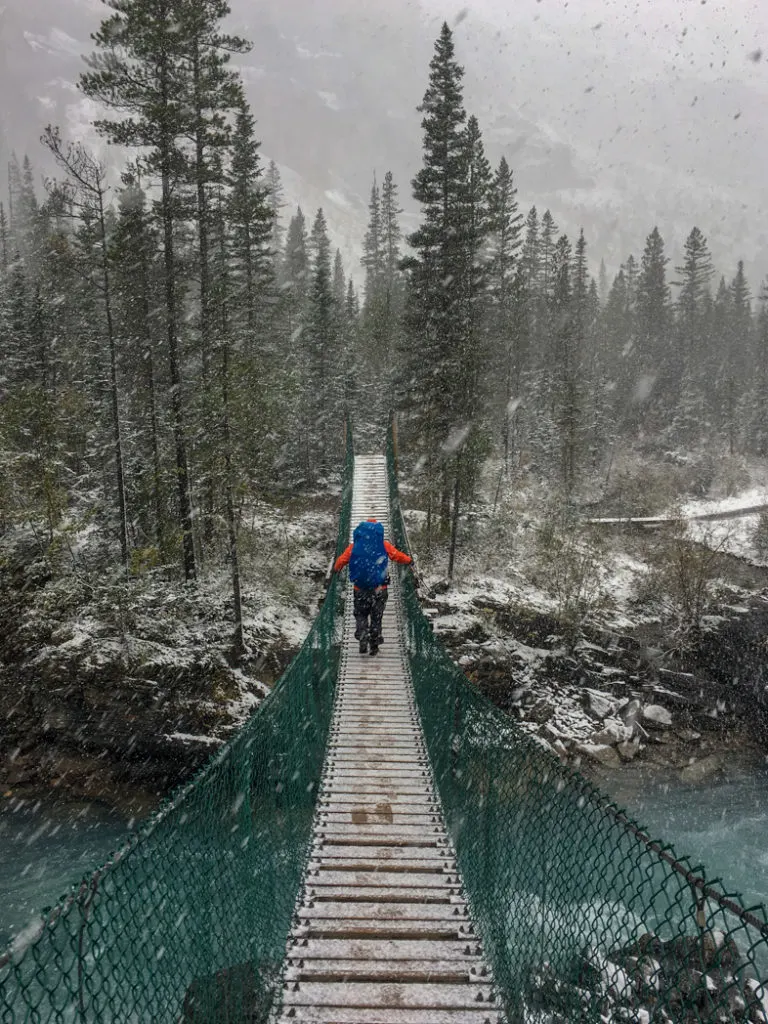
Join the Backpacking in BC Facebook Group
Toiletries, First Aid and Safety
Toothpaste and Toothbrush
There’s a grey water pit at each campsite that you can use for your dish water and tooth brushing. But remember to use your own filtered or treated water to brush your teeth.
Deodorant and Wet Wipes
You’ll be getting sweaty every day. Bring a small travel sized deodorant and some wet wipes for having a quick sponge bath at the end of the day.
I recommend: I used to use specialized face wipes from the beauty section of the drug store, but then I realized baby wipes are waaay cheaper. Before each trip I pull a bunch out of the package, fold them up into little squares, then put then in a ziploc bag with all the air squeezed out. They stay moist for weeks that way.
Sunscreen and Lip Balm
The harsh sun at high elevations can give you a sunburn in just a few minutes. Pack sunscreen and SPF lip balm to protect yourself.
I recommend: I like Neutrogena sport sunscreen since it is oil free. I use Blistex lip balms. They have an SPF rating of 15 (so you have to reapply often) but they don’t feel too waxy like some others I’ve tried.
Bug Spray and/or Head Net
If you’re hiking in June or July, the mosquitos can be fierce. Bring bug spray or a head net.
I recommend: I like to wear a head net since I don’t like putting chemicals on my face. Be sure to pack a baseball cap or wide brimmed hat to wear underneath – it keeps the netting off your face. Check prices: MEC | Amazon
Hair Brush and Hair Ties
If you’ve got long hair, you know why you need these.
Contact Solution and Spare Lenses
If you wear contacts, be sure to pack contact solution and extra lens. On cold nights, sleep with your contact case inside your sleeping bag to keep them from freezing.
Toilet Paper and Hand Sanitizer
There are outhouses at every campsite, but toilet paper isn’t supplied. Bring your own packed inside a Ziploc bag to keep it dry. Carry a small bottle of hand sanitizer to clean your hands after you use the toilet and before you eat.
Menstrual Supplies
If you expect your period on the trail, be sure to pack your favourite menstrual supplies. Learn more about how to camp and hike while on your period.
First Aid Kit
You should pack a small first aid kit. Make sure it includes bandages, gauze, medical tape and a compression bandage for sprains. You’ll also want to have lots of foot care supplies such as Moleskin or Second Skin for blisters. (Check out my full list of blister care and prevention tips and tricks.) Bring anti-inflammatory painkillers like Advil, and anti-diarrhea pills like Immodium just in case. And of course don’t forget your usual prescription medications.
Your first aid kit should also contain stuff to help repair your gear in case you have any problems. We packed a small multi-tool and some duct tape.
I recommend: I like the Adventure Medical Ultralight first aid kits since they come in a water resistant pouch. I always add more stuff to them, like more blister care and bandaids. Check prices: MEC | REI. A multi-tool with a knife, pliers and scissors is always handy. I like the Leatherman Squirt because it’s small. Check prices: MEC | REI
Bear Spray
The Canadian Rockies are home to both black bears and grizzly bears. While both species tend to stay away from the trail, bears are occasionally spotted. Carry bear spray and make lots of noise when hiking. I’ve got lots more tips for hiking and camping in bear country.
Electronics
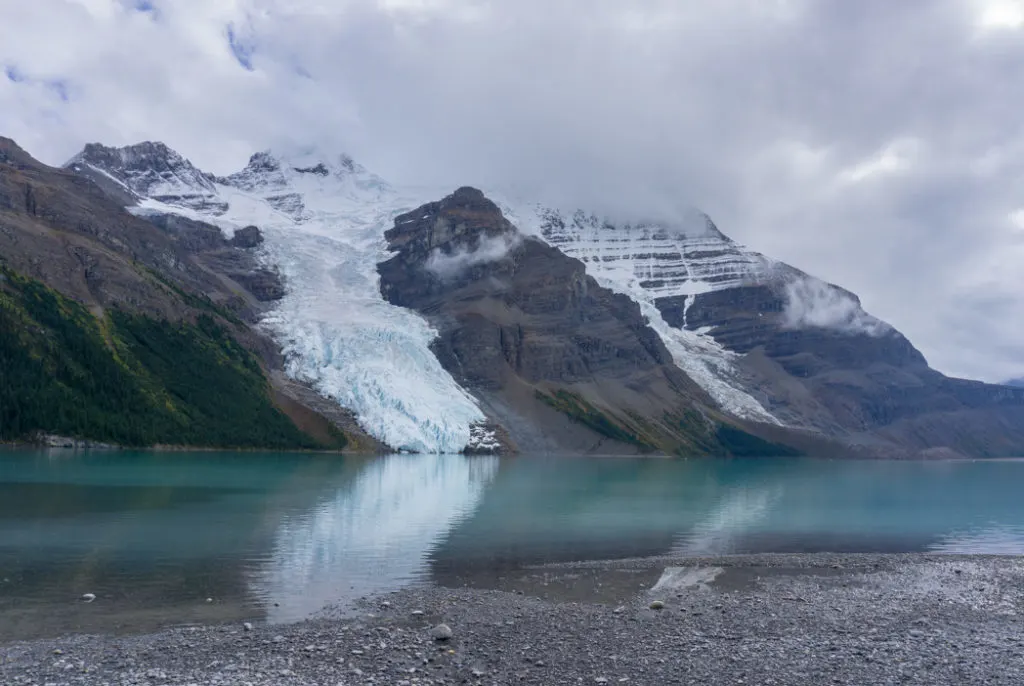
Camera
Berg Lake is spectacular and you’ll want to make sure you have a good way to take photos. Of course you can bring your phone to use as a camera, but you may want to bring a stand alone camera or GoPro. (There’s no cell service at Berg Lake.)
I recommend: I brought my Sony A6000. It’s a mirrorless camera which is more compact than a full DSLR but still produces high quality images. I find it easy to use, plus it’s not that expensive. Buy: Amazon.
Headlamp and Extra Batteries
Bring a headlamp to find your way around after dark.
I recommend: I use a Petzl Actik. It’s super bright and easy to use. Plus the batteries last a long time on low power. Buy: MEC | REI | Backcountry.com.
Power Bank (Optional)
If you’re bringing a lot of electronics (phone, camera, GPS, etc.), you’ll need a way to keep them all charged.
I recommend: Bring a power bank that has enough storage to charge your devices at least once, but isn’t too big and heavy. The size you choose will depend on how many devices you bring, but at least 2,500mAh capacity or larger is probably a good idea. Check prices: MEC | REI | Amazon.
Lantern (Optional)
If you stay at a campsite with a shelter (Berg Lake, Kinney Lake, or Whitehorn), you might want to bring a small battery powered lantern. They throw better light than a headlamp and create a cozy atmosphere for cooking, playing cards or hanging out.
I recommend: I have an older Black Diamond Apollo lantern. Check prices: MEC | REI | Black Diamond. If you’re looking for something super small yet bright AND solar powered, the Luci lanterns are really cool. Check prices: REI | Amazon.
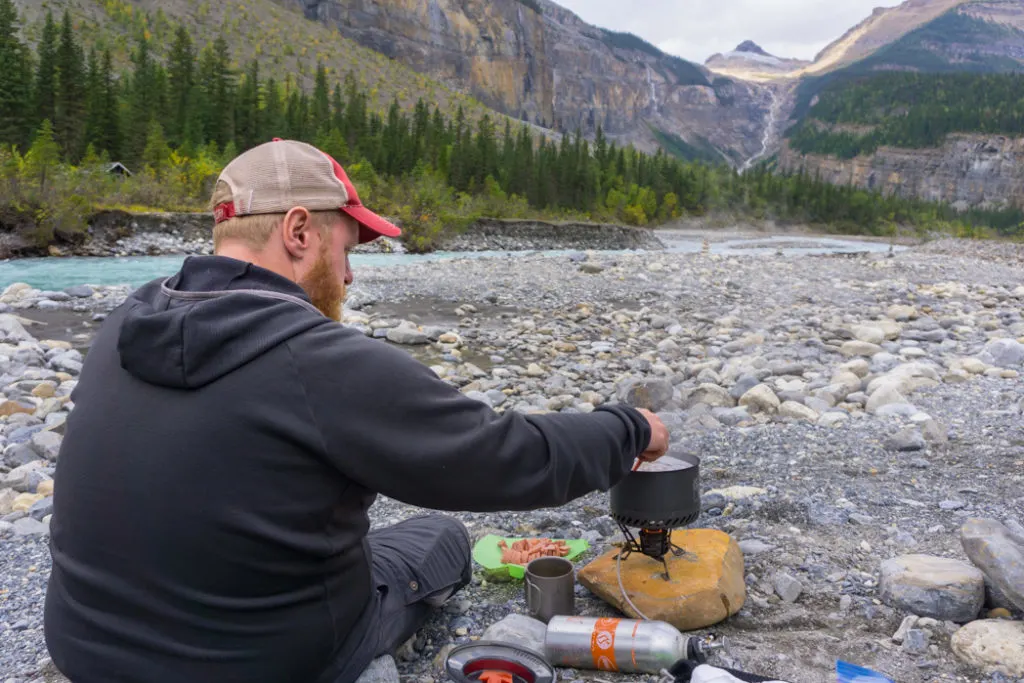
Cooking Gear
Stove, Fuel, and Lighter
Fires aren’t allowed on the Berg Lake Trail so you will need to do all your cooking on a backpacking stove. Bring a lightweight and compact stove and remember to bring enough fuel for your trip. Don’t forget a lighter!
I recommend: The Snow Peak Giga stove is incredibly lightweight and compact. Check prices: REI | Amazon.
Cooking Pot
Choose lightweight camping pots. Unless you are making elaborate meals, you probably just need one pot.
I recommend: We use a Primus Primetech pot that has a built in heat exchanger that optimizes fuel consumption and protects the flame from the wind. Check prices: MEC | Amazon | Backcountry.
Bowl
Bring a lightweight bowl to eat out of.
I recommend: I like the Sea to Summit X Bowls since they are collapsible and I can store them inside my cooking pot. Check prices: MEC | REI | Amazon.
Mug
You’ll want hot drinks to warm you up on cold evenings. A double-wall insulated mug keeps your drinks warm for longer.
I recommend: After years of being jealous of my husband’s, I recently upgraded to a fancy Snow Peak Titanium mug with double walls. So light! So warm! Check prices: MEC REI | Amazon.
Knife and Utensils
Bring a sharp knife for cutting, plus a spoon and fork for eating. Or get a spork – they do double duty!
I recommend: I love my Snow Peak Titanium spork. Check prices: MEC | REI | Amazon. I use a basic Gerber folding knife. Check prices: REI | Amazon.
Dishwashing Supplies
We carry a small pot scraper, a tiny microfibre cloth and some biodegradable soap. Use soap sparingly and be sure to pour your dish water into the grey water pits at each campground. Don’t put soapy water directly into streams since even biodegradable soap isn’t safe to go directly into the water.
I recommend: The GSI compact scraper has a hard edge for scraping stuck on stuff and a spatula-like edge for scraping softer stuff. Check prices: MEC | REI | Amazon. We use Dr. Bronner’s soap for really greasy dishes. It’s organic and biodegradable. Check prices: MEC | Amazon
Food and Water
Water Treatment
Drinking untreated water is a sure-fire way to get sick. Make sure you filter or treat all water on the Berg Lake Trail.
I recommend: We brought our Platypus Gravityworks filter. It is really easy to use since there’s no pumping or squeezing. You just hang it up and let it drip through. Check prices: MEC | REI | Amazon.
Water Bottles
Bring a couple of water bottles or a hydration reservoir. There are streams at regular intervals along the trail so you won’t need to carry more than 1.5 or 2 litres at a time.
I recommend: I use a Platypus Big Zip hydration reservoir so I can keep drinking as I hike. Check prices: MEC
Food
Bring lots of high calorie food that is lightweight and compact. Don’t forget the snacks! You’ll burn more calories hiking than on a usual day so don’t be afraid to pack a little extra.
I recommend: Check out my tips for choosing the best backpacking meals.
Food Bag
You’ll be storing your food inside big metal lockers and you’ll need to share the space with all the other campers. Bring a lightweight stuff sack to keep your food contained and organized.
I recommend: I used the SealLine Bulkhead View dry bags. They’re waterproof, they have a purge valve to squeeze out excess air and the window makes it easier to figure out what’s inside. Check prices: MEC | REI | Amazon.
Optional Extra Gear
Cooking Gear
Stove, Fuel, and Lighter
Fires aren’t allowed on the Berg Lake Trail so you will need to do all your cooking on a backpacking stove. Bring a lightweight and compact stove and remember to bring enough fuel for your trip. Don’t forget a lighter!
I recommend: The Snow Peak Giga stove is incredibly lightweight and compact. Check prices: REI | Amazon.
Cooking Pot
Choose lightweight camping pots. Unless you are making elaborate meals, you probably just need one pot.
I recommend: We use a Primus Primetech pot that has a built in heat exchanger that optimizes fuel consumption and protects the flame from the wind. Check prices: Altitude Sports | Amazon | Backcountry.
Bowl
Bring a lightweight bowl to eat out of.
I recommend: I like the Sea to Summit X Bowls since they are collapsible and I can store them inside my cooking pot. Check prices: MEC | REI | Amazon.
Mug
You’ll want hot drinks to warm you up on cold evenings. A double-wall insulated mug keeps your drinks warm for longer.
I recommend: After years of being jealous of my husband’s, I recently upgraded to a fancy Snow Peak Titanium mug with double walls. So light! So warm! Check prices: MEC REI | Amazon.
Knife and Utensils
Bring a sharp knife for cutting, plus a spoon and fork for eating. Or get a spork – they do double duty!
I recommend: I love my Snow Peak Titanium spork. Check prices: MEC | REI | Amazon. I use a basic Gerber folding knife. Check prices: REI | Amazon.
Dishwashing Supplies
We carry a small pot scraper, a tiny microfibre cloth and some biodegradable soap. Use soap sparingly and be sure to pour your dish water into the grey water pits at each campground. Don’t put soapy water directly into streams since even biodegradable soap isn’t safe to go directly into the water.
I recommend: The GSI compact scraper has a hard edge for scraping stuck on stuff and a spatula-like edge for scraping softer stuff. Check prices: MEC | REI | Amazon. We use Sea to Summit Pocket Wilderness Wash for really greasy dishes. They come in little soap sheets that are much less messy than liquid. Check prices: MEC
READ NEXT: Beyond Oatmeal: 6 Hot Backpacking Breakfasts
Food and Water
Water Treatment
Drinking untreated water is a sure-fire way to get sick. Make sure you filter or treat all water on the Berg Lake Trail.
I recommend: We brought our Platypus Gravityworks filter. It is really easy to use since there’s no pumping or squeezing. You just hang it up and let it drip through. Check prices: MEC | REI | Amazon.
Water Bottles
Bring a couple of water bottles or a hydration reservoir. There are streams at regular intervals along the trail so you won’t need to carry more than 1.5 or 2 litres at a time.
I recommend: I use a Platypus Big Zip hydration reservoir so I can keep drinking as I hike. Check prices: MEC
Food
Bring lots of high calorie food that is lightweight and compact. Don’t forget the snacks! You’ll burn more calories hiking than on a usual day so don’t be afraid to pack a little extra.
I recommend: Check out my tips for choosing the best backpacking meals and my guide to making cheap backpacking meals with grocery store ingredients.
Food Bag
You’ll be storing your food inside big metal lockers and you’ll need to share the space with all the other campers. Bring a lightweight stuff sack to keep your food contained and organized.
I recommend: I used the SealLine Bulkhead View dry bags. They’re waterproof, they have a purge valve to squeeze out excess air and the window makes it easier to figure out what’s inside. Check prices: MEC | REI | Amazon.
Optional Extra Gear
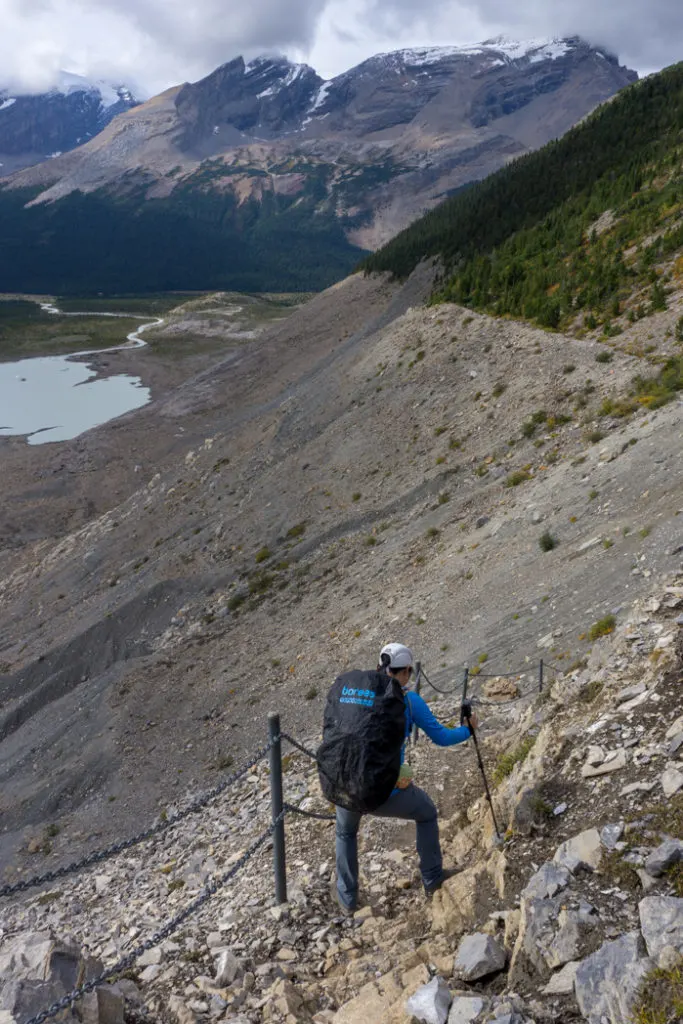
Trekking Poles
The Berg Lake Trail has a lot of steep ascents and descents. Trekking poles can be really helpful for saving your joints on the downhills.
I recommend: I brought my Black Diamond Trail trekking poles and was really happy to have them. Check prices: MEC | REI | Amazon | Black Diamond.
Tripod or Selfie Stick
The photography opportunities at Berg Lake are epic. I wish I had brought my tripod!
I recommend: If you’re trying to go really light, get a Joby Gorillapod mini tripod. It’s lightweight and compact, plus its easy to attach to just about anything. You can also get an adapter that lets you use it with your phone. Check prices: REI | Amazon. I also have a Sirui T-025X Carbon Fiber full-sized tripod that I wished I had brought. Check prices: Amazon
Entertainment for Camp
You’ll have a few hours each night in camp when you’ll need to entertain yourself. Consider bringing a book or some headphones to listen to music or podcasts. The campsites with shelters can be really social so a deck of cards or a compact game can be a good way to meet new friends.
I recommend: I always travel with my Amazon Kindle eReader so I have hundreds of books to choose from. We’ve brought the card game Exploding Kittens on a few backpacking trips and it’s always a hit.
Seat Cushion or Ultralight Chair
After a long day on the trail, sitting on the cold ground or a hard picnic table bench to make dinner doesn’t sound that nice.
I recommend: I have a simple folding foam pad from Thermarest. Check prices: MEC | Amazon. Recently we picked up some ultralight Helinox Chair Ones. They weigh 1kg, which is light enough to bring on some backpacking trips. It’s up to you if you want to carry the extra weight (My husband almost always decides its worth it. I only carry a chair sometimes.) Check prices: MEC | Amazon
Join the Backpacking in BC Facebook Group
Stuff You Don’t Need to Pack for the Berg Lake Trail
Here’s my list of stuff you don’t need and shouldn’t pack for your Berg Lake Trail hike:
- Climbing gear: The trails are non-technical and you won’t need harnesses, ropes, crampons, etc. However, if you do plan to climb some of the peaks nearby, you will need climbing gear, plus the knowledge of how to use it.
- Hammocks: They aren’t allowed on the trail since they can damage trees.
- Tons of outfit changes: Everyone else will be wearing the same stinky clothes over and over, so you can too. Plus it’s just too heavy to pack an outfit for every day.
- Portable speakers: Most people come to Berg Lake to appreciate the sounds of nature and prefer not to hear your music. The campsites can also be really close together, so you’ll want to keep the noise down.
- Saw or axe: Campfires aren’t allowed in the park so you won’t need to chop wood. Two of the campsites have wood stoves that can be used in an emergency, but they also come with an axe so you don’t need to bring your own.
- Your dog: Dogs are permitted on leash on day hikes in the park, but they aren’t allowed on overnight trips.
READ NEXT: Berg Lake Trail: The Ultimate Hiking Guide
Have you hiked to Berg Lake? Is there anything you’d add or remove from this list? Let me know in the comments.
MORE CANADA POSTS:
- The Ultimate Guide to Hiking the Berg Lake Trail
- Your Guide to Camping and Hiking at Lake O’Hara in Yoho National Park
- How to Take an Epic Canadian National Parks Road Trip
- Your Guide to the Best Hot Springs in Canada
- Your Guide to the West Coast Trail in British Columbia
MORE HIKING GEAR POSTS:
- 20+ Ways to Reduce Your Backpack Weight
- 17 Ways to Save Money on Hiking Gear
- How to Stay Warm in a Tent: Over 40 Tips
- 12 Best Women’s Hiking Pants (Picks for Every Body Type)
- Best Hiking Underwear For Women and Men
- Which Women’s Hiking Gear is Actually Worth Buying?
- Women’s Plus Size Hiking Clothes: The Best Brands and Where to Find Them
- Snow-Free Hikes in Vancouver: 50+ Year-round Trails - December 4, 2025
- 2025 Altitude Sports Black Friday Sale: My Picks for the Best Deals - November 25, 2025
- Bowron Lakes Canoe Circuit: 2026 Paddling Guide - November 20, 2025

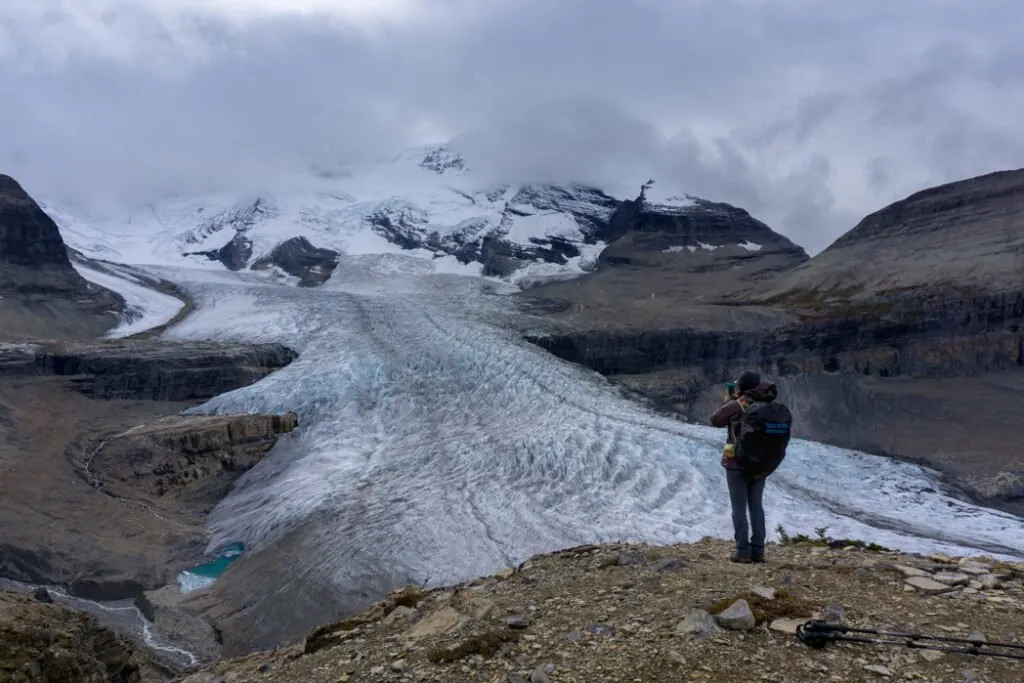

Jodi
Tuesday 2nd of February 2021
Awesome article. My husband has been on this trail many times, & now it’s time to head their with our teens! Hope to in 2021.